I have really enjoyed Part Five of the Course because I had a sense of things coming together for me. I found my drawing improving with this being a major challenge for me at the beginning of the Course. I understood how to drill down on a theme and focus on a few elements and the ideas kept coming and still are coming. Importantly I found I had more organisation and structure to my work. I think the analysis at the end of Part 4 on “A Structured Approach to Reflective Thinking” leaning heavily on the work of Cottrell(2011,p211)help me to approach Part Five in a more cohesive way.
The model I presented of critical reflection encouraged me to do a “Review of Formative Feedback”(blogpost March 30, 2017) for assignments 1, 2 and 3, for example the question I posed to myself in terms of Assignment One Feedback “Have I looked hard at other practioner’s work and fed that into my own practice? provided me with a prompt as I commenced Part 5 to ensure I documented my Research of other Practioner’s who I was drawn to (e.g. Dorothy Caldwell, Bobby Britnell). The reminder to draw in a range of mediums, to draw without looking on large A2 paper all were highlighted to me. I also did an update of the book “Steal like an Artist”. The review of the feedback from Assignment Two also encouraged me to include more photographs from my sketchbook,and to use to water soluble crayons and other materials. I took on board the feedback from Assignment Four also and revisited Debbie Lyddon’s Book and provided more in-depth analysis.
In terms of my Model which is a continuous loop Model I followed along on the Acting and Experience by research gathering and documenting this, by preparing a portfolio of work. I reflected on my previous creative experience in Assignments 1,2,3 and 4 and my current experience. I tried to integrate my reflections with ideas and approaches by other artists and I think I achieved this at least to be influenced by Caldwell, Britnell, Blake and Streefkerk in Part 5. Review and Assessment I will comment further below and finally evaluating in terms of my development.
Overall for Part 5 I have had a shift in my thinking about my textile work. For the first time I feel a deeper relationship to my subject matter to what I am doing and how I am doing it in some way it feels part of me. It is not just a selection of techniques it is more than that. I have also come to value the use of the sketchbook (I have to confess I was trained by a master US quilter to work intuitively with no sketchbook)as my place to sort out ideas and experiment I still have work to do though. I think I better managed my time in Part 5 but there is still room for improvement. I understand so much better now what I need to do than when I started the course.
The course in general has provided so much to me in way of my textile work. I feel so enriched by the experience. I now approach my work from a deeper mindset. This has had a very positive effect on my other textile work outside of this course. I plan to enrol in the Mixed Media in Textiles Course next. I will enter Exhibitions also (I have done this already) but be more experimental and less risk adverse with my approach. The course has stimulated me to think of textiles far more broadly and I look forward to expanding in this context further.




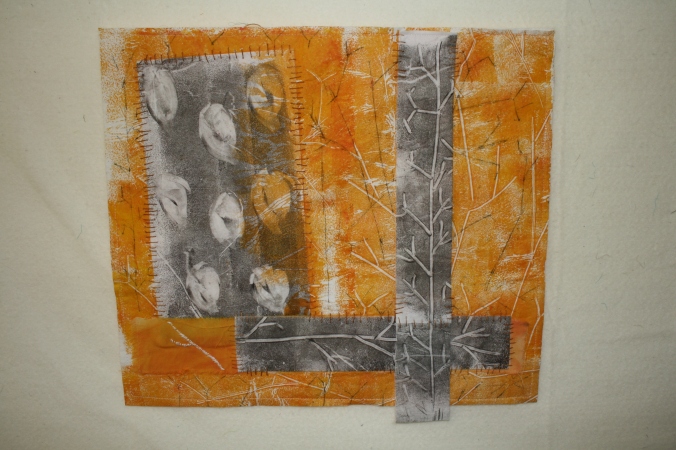 SAMPLE TWO size 21cm by 51cm
SAMPLE TWO size 21cm by 51cm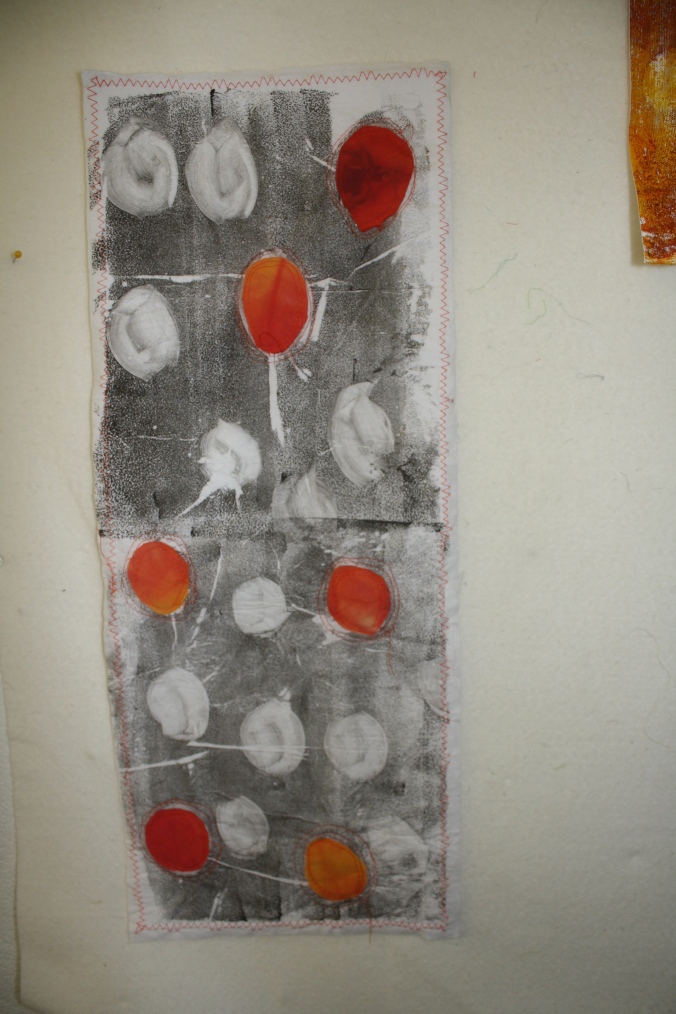
 SAMPLE FOUR -size 28cm by 38cm
SAMPLE FOUR -size 28cm by 38cm

 Here is a photo of all the pieces up on my design wall (really just polystyrene and some thin batting!).
Here is a photo of all the pieces up on my design wall (really just polystyrene and some thin batting!). I will write my Written Reflection to Part Five in a following blogpost.
I will write my Written Reflection to Part Five in a following blogpost.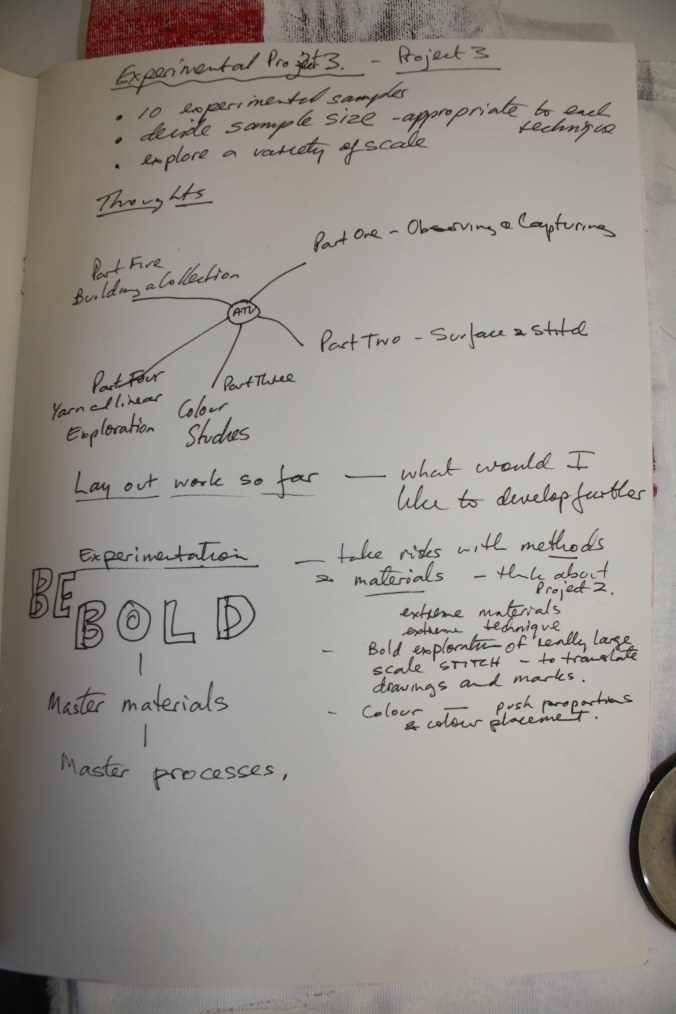


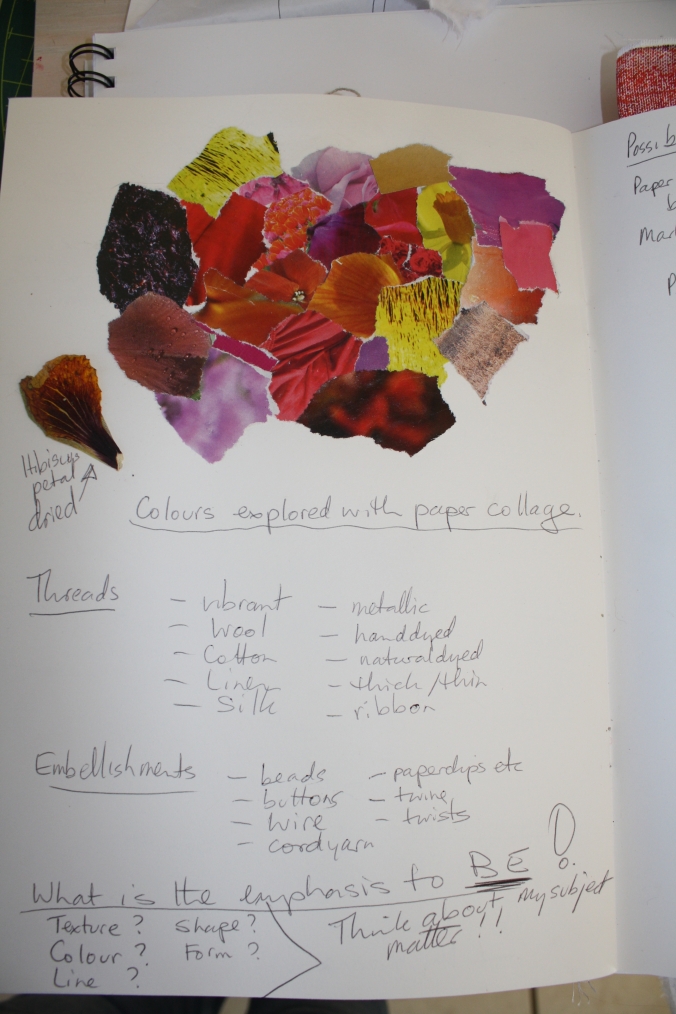
 Having undertaken this documented approach and due consideration to my experimental work I next decided to make the samples based on my experimentation being the materials and mark making for the background work for Assignment 5 with the restricted colour palette informed by my colour collage work in my sketchbook.
Having undertaken this documented approach and due consideration to my experimental work I next decided to make the samples based on my experimentation being the materials and mark making for the background work for Assignment 5 with the restricted colour palette informed by my colour collage work in my sketchbook.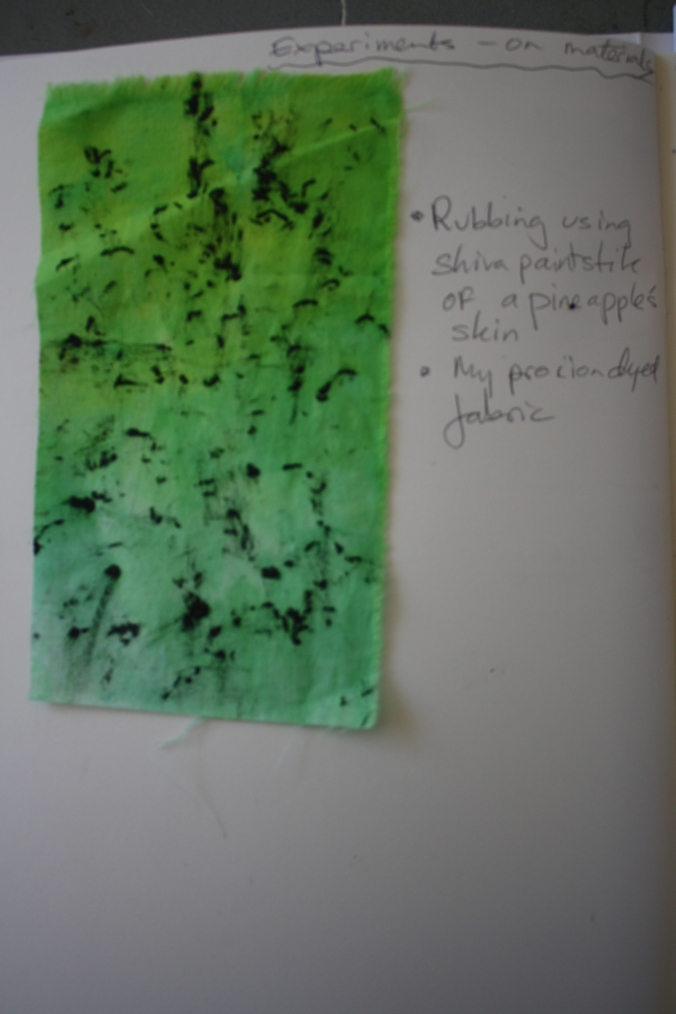












 I think that my Experimental textile samples will be very helpful for my approach to Assignment Five.
I think that my Experimental textile samples will be very helpful for my approach to Assignment Five. Dorothy recently did a series of work based on using earth to dye her fabric. She undertook residencies in the Australian Outback and the Canadian Arctic. Her process was to fill many small journals with images, drawings and paper dyed from natural sources thus recording fragments of the places she was studying. Many of Dorothy’s art pieces are large as evidenced in the Cover photograph above. She references objects she finds on her walks in these remote areas and indigenous art. Dorothy sees the stitch as very important to the mark making seeing it as a dot, a line and a texture. The stitches are like running stitch, kantha stitch, darning and mending stitches and she is quoted as being inspired by this Louise Bourgeois quote:
Dorothy recently did a series of work based on using earth to dye her fabric. She undertook residencies in the Australian Outback and the Canadian Arctic. Her process was to fill many small journals with images, drawings and paper dyed from natural sources thus recording fragments of the places she was studying. Many of Dorothy’s art pieces are large as evidenced in the Cover photograph above. She references objects she finds on her walks in these remote areas and indigenous art. Dorothy sees the stitch as very important to the mark making seeing it as a dot, a line and a texture. The stitches are like running stitch, kantha stitch, darning and mending stitches and she is quoted as being inspired by this Louise Bourgeois quote: I decided to paint paper with watercolour paint to form part of my paper yarn collection. Next red acrylic paint was used on decovil and also on bondaweb this reflects the colour of my frangipani and some hibiscus and also my Georgia O’Keefe theme of red as discussed earlier.
I decided to paint paper with watercolour paint to form part of my paper yarn collection. Next red acrylic paint was used on decovil and also on bondaweb this reflects the colour of my frangipani and some hibiscus and also my Georgia O’Keefe theme of red as discussed earlier. I cut the copy paper I had painted with orange and red watercolour paint into sizes around one quarter inch wide.
I cut the copy paper I had painted with orange and red watercolour paint into sizes around one quarter inch wide.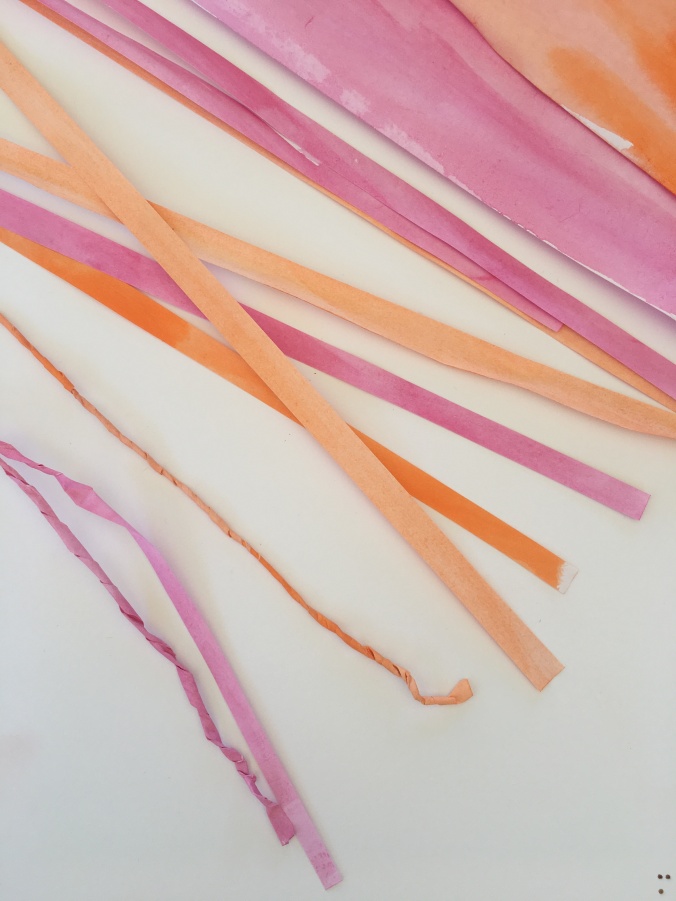 I then finger twisted the paper using my index finger and my thumb to make uneven type twists.
I then finger twisted the paper using my index finger and my thumb to make uneven type twists. I also used the twisted paper yarn to make round flower like shapes on a background of two strips of the painted paper.
I also used the twisted paper yarn to make round flower like shapes on a background of two strips of the painted paper. Here is a photograph of the pieces and my colour inspiration a hibiscus flower which has finished flowering. I love the texture of the hibiscus flower petals it is crepe like. I was happy with the way my coloured paper yarns reflect the colour and texture to some degree of the spent hibiscus flower.
Here is a photograph of the pieces and my colour inspiration a hibiscus flower which has finished flowering. I love the texture of the hibiscus flower petals it is crepe like. I was happy with the way my coloured paper yarns reflect the colour and texture to some degree of the spent hibiscus flower. The next piece uses the bondaweb which I painted with the red acrylic paint and then using an iron adhered to white cotton. I then created a frangipani stamp quickly using adhesive foam and stamped several petals onto of the adhered bondaweb. I sewed the piece together using a machine embroidery stitch for extra texture. This technique has endless possibilities but maybe not so much as a yarn.
The next piece uses the bondaweb which I painted with the red acrylic paint and then using an iron adhered to white cotton. I then created a frangipani stamp quickly using adhesive foam and stamped several petals onto of the adhered bondaweb. I sewed the piece together using a machine embroidery stitch for extra texture. This technique has endless possibilities but maybe not so much as a yarn. My next piece uses the painted decovil which is a synthetic cardboard like adhesive on one side fabric. I stamped the frangipani using yellow acrylic paint and then placed eyelets in the middle of each frangipani. I was encouraged by my Tutor in Part 4 to take the eyelet designs further. This worked alright but the frangipani was a little pale. Using the decovil means that the edges will not unravel and this could be used as a trim or bookmark.
My next piece uses the painted decovil which is a synthetic cardboard like adhesive on one side fabric. I stamped the frangipani using yellow acrylic paint and then placed eyelets in the middle of each frangipani. I was encouraged by my Tutor in Part 4 to take the eyelet designs further. This worked alright but the frangipani was a little pale. Using the decovil means that the edges will not unravel and this could be used as a trim or bookmark.
 I used gardeners wire to make this one and think this could be useful as a yarn.
I used gardeners wire to make this one and think this could be useful as a yarn.
 As noted I certainly did not achieve the same movement as Georgia but undertaking the study improved my observation skills. Georgia used charcoal I used graphite pencil. Taking my drawing further I decided to make a foam stamp of the main outlines and to print the positive and negative using one of Georgia’s favourite colours ‘red’.
As noted I certainly did not achieve the same movement as Georgia but undertaking the study improved my observation skills. Georgia used charcoal I used graphite pencil. Taking my drawing further I decided to make a foam stamp of the main outlines and to print the positive and negative using one of Georgia’s favourite colours ‘red’.

 I kept going and sprayed the paper backing from the foam stencil with Tumble Dye and again used positive and negative.
I kept going and sprayed the paper backing from the foam stencil with Tumble Dye and again used positive and negative.

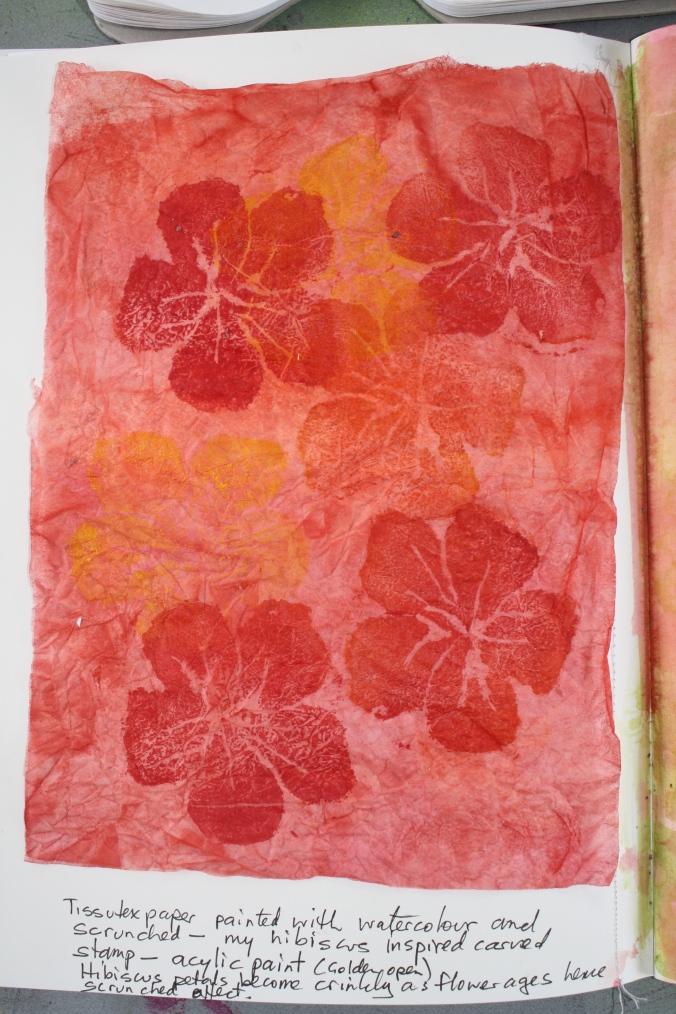
 I was a little over all the colour so I created a small simple piece using washi tape and a pen outline of leaves similar to tropical leaves. I think this would work for wallpaper.
I was a little over all the colour so I created a small simple piece using washi tape and a pen outline of leaves similar to tropical leaves. I think this would work for wallpaper. I returned to the colour for the next piece which was my attempt to recreate the texture of the pineapple skin (Project 1 Part 5 drawing) which is really rough. I used light molding paste again which is not heavy on the sketchbook page and a colour wash. I am not so happy with this it has texture and shape but I am not sure it conveys much meaning.
I returned to the colour for the next piece which was my attempt to recreate the texture of the pineapple skin (Project 1 Part 5 drawing) which is really rough. I used light molding paste again which is not heavy on the sketchbook page and a colour wash. I am not so happy with this it has texture and shape but I am not sure it conveys much meaning. The last piece I did was to capture the actual bougainvillea flower petals within florist cellophane. I put a piece of linen thread in too to see how it went. I used a hot iron with the cellophane between two pieces of baking paper. I was happy with the result it achieved my aim of depicting the flower petals as light and floaty.
The last piece I did was to capture the actual bougainvillea flower petals within florist cellophane. I put a piece of linen thread in too to see how it went. I used a hot iron with the cellophane between two pieces of baking paper. I was happy with the result it achieved my aim of depicting the flower petals as light and floaty.
